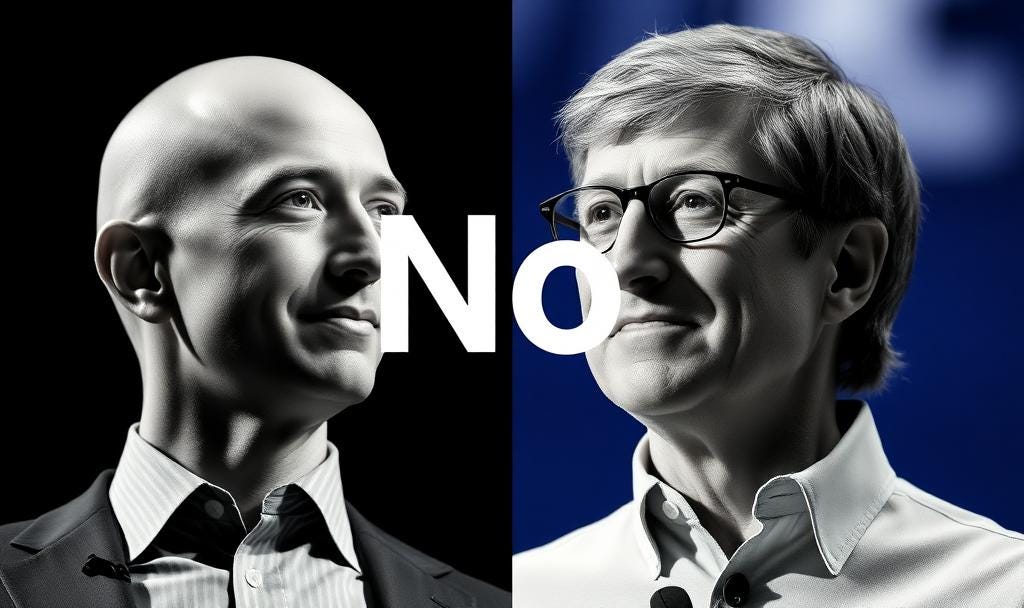💰Learn to say NO! And you’ll make A LOT more money
How to gain nearly 3 weeks of additional time a year by saying no like Gates and Bezos.
Saying no is not a weakness, as some would think.
Most founders waste years in the “trivial” tasks that could be outsourced or deprioritized. Learn what Gates and Bezos do best below and how they zoomed in on the small set of inputs that created outsized results.
That discipline is what turns startups into empires.
Let’s do a reality check, do you try to say yes to every opportunity, client, or meeting and then often find yourself overworked and underpaid? You’re definitely not alone. Small business owners waste an average of 96 minutes a day on the noise of distractions (Salesforce, 2024). That’s three weeks a year of lost focus.
As the owner of Zen Management US | UAE, I commit to giving my best to every client because each one has been hand-selected based on the firm’s top priorities and competencies. That’s why today’s article covers the art and science of saying no, so you can protect your focus and scale on your own terms and not bend to the whims of every request.
Why Saying No Is Your Growth Lever
Imagine logging 70 hours in a week and realizing you produced no more than if you had worked 55. Stanford research confirms that after 50 hours, productivity per hour falls sharply (Atlassian, 2024). Burnout and wasted effort become your only return.
Founders like Bill Gates and Jeff Bezos scaled because they worked inside their
20% zone of highest leverage.
Founders like Bill Gates and Jeff Bezos scaled because they worked inside their 20% zone of highest leverage. They didn’t chase everything. They chose the right things.
Micro Case Study - GATES & BEZOS
Gates concentrated his energy on software architecture and long-term product vision. That was his 20% zone of highest leverage. By delegating operations and sales, he scaled Microsoft without diluting his impact.
Bezos obsessed over systems and customer experience. His 20% zone was designing infrastructure—things like Prime, one-click purchasing, and fulfillment centers that shaped Amazon’s trajectory. He delegated everything else.
LEARNING:
Both founders built empires by protecting their focus and consistently saying no to low-impact distractions. Their success proves that discipline in choosing what not to do is as important as deciding what to do.saying no to low-impact distractions. Their success proves that discipline in choosing what not to do is as important as deciding what to do.The Top 7 Focus and Boundary Tactics
1. Apply the Pareto Principle (80/20 Rule)
Eighty percent of your results usually come from twenty percent of your inputs. Identify the top clients, projects, or channels that actually drive profit. Eliminate or delegate the rest.
Recommended Tools: Asana, ClickUp
2. Audit Your Week Ruthlessly
Track where every hour goes. You’ll see which tasks should be delegated, automated, or killed. One founder who cut “low ROI” client work replaced it with million-dollar clients in a month.
Recommended Tools: RescueTime, Toggl
3. Set Hard Boundaries Around Time
Block time for strategic work. Treat it like an unbreakable client meeting. Use a two-filter test: does this meeting or task align with priorities and deliver measurable ROI? If not, decline.
Recommended Tools: Google Calendar, Motion
4. Fire Clients Who Drain Resources
Some clients cost more in headaches than they pay in invoices. Frame it as misalignment, not rejection. Transition gracefully, refer alternatives, and free space for better-fit opportunities.
💬 Did you know? Forty percent of small business owners admit they held onto clients who weren’t profitable just to avoid the tough conversation (Lifehack Method, 2024).
Keep reading with a 7-day free trial
Subscribe to The Zen Growth Playbook to keep reading this post and get 7 days of free access to the full post archives.


